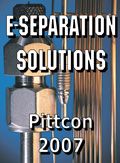Separation Instrumentation Demand
Separation instrument techniques are among the most widely used technologies in the analytical instrumentation market. It spans the entire industrial and regional marketplace. The lab separations market includes chromatographic techniques like analytical and preparative HPLC, GC, IC, TLC, flash, and low pressure LC.
Separation instrument techniques are among the most widely used technologies in the analytical instrumentation market. It spans the entire industrial and regional marketplace. The lab separations market includes chromatographic techniques like analytical and preparative HPLC, GC, IC, TLC, flash, and low pressure LC.

Separation Instrumentation DemandThe separation instrumentation market continues to expand, especially as global economic conditions strengthen. The growth in life science applications in both research and quality control has certainly had a positive impact on the separations market. Pharmaceutical and biotechnology companies have provided the stimulus for market growth over the last several years. These industries heavily rely on separation technique to conduct their innovative research activities.
While the demand of separation instruments is dependent on North America and Europe, which account for the majority of the separations market, the Asia/Pacific Rim, including Japan, China, India, and Australia, is poised for robust growth over the next few years. Many of the top pharmaceutical and chemical companies are expanding its presence in this region, particularly in China and India. Asia/Pacific Rim is known for its efficient manufacturing capabilities, but is expected to play a stronger role in R&D activities as well.
India has been undergoing rapid technological and economic development. Because of the many fluent English speakers, India is more easily addressed by Western economies. Australia also offers strong growth opportunities, especially since its modern economy is much more heavily tied to Western Europe and the United States.
Despite the progress in Southern Asia, this region is still considered to be somewhat risky for Western companies due to exchange rates, economic, and political factors. Nonetheless, many separation instrument manufacturers are also establishing a stronger presence in Asia/Pacific Rim by opening manufacturing and sales offices to take advantage of any potential this region has to offer.
The foregoing data was extracted from SDi’s Market Analysis and Perspectives report entitled: SDi’s Global Assessment Report, 9th Edition: The Laboratory Life Science & Analytical Instrumentation Industry (2006-2010). Contact Glenn Cudiamat, VP of Research Services, Strategic Directions International, Inc., 6242 Westchester Parkway, Suite 100, Los Angeles, CA 90045, tel. (310) 641-4982, fax (310) 641-8851, e-mail cudiamat@strategic-directions.com.
Polysorbate Quantification and Degradation Analysis via LC and Charged Aerosol Detection
April 9th 2025Scientists from ThermoFisher Scientific published a review article in the Journal of Chromatography A that provided an overview of HPLC analysis using charged aerosol detection can help with polysorbate quantification.
Removing Double-Stranded RNA Impurities Using Chromatography
April 8th 2025Researchers from Agency for Science, Technology and Research in Singapore recently published a review article exploring how chromatography can be used to remove double-stranded RNA impurities during mRNA therapeutics production.









